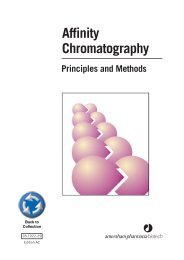Mutation of YCS4, a Budding Yeast Condensin Subunit - Molecular ...
Mutation of YCS4, a Budding Yeast Condensin Subunit - Molecular ...
Mutation of YCS4, a Budding Yeast Condensin Subunit - Molecular ...
You also want an ePaper? Increase the reach of your titles
YUMPU automatically turns print PDFs into web optimized ePapers that Google loves.
<strong>Condensin</strong> Function and Chromosome Behavioran attempt <strong>of</strong> the cell to facilitate the separation and segregation<strong>of</strong> this heterochromatin-like locus (Bryk et al., 1997;Fritze et al., 1997; Smith and Boeke, 1997).The rDNA differs from the remainder <strong>of</strong> the genome intwo ways: it is present as a large array <strong>of</strong> tandem repeats,and a fraction <strong>of</strong> the repeats is transcribed at very high rates.Transcription produces topological effects that may interferewith proper chromosome segregation. Plant and animal cellsdeal with this problem by shutting down transcription duringmitosis, but in budding yeast, transcription continuesduring mitosis, which can occupy a large fraction <strong>of</strong> the cellcycle. We speculate that the presence <strong>of</strong> condensin at thenucleolus relieves the topological constraints produced bytranscription, thus facilitating separation and segregation <strong>of</strong>the rDNA.<strong>Condensin</strong> also appears to be required for the stability <strong>of</strong>artificial chromosomes containing repetitive satellite DNA(Freeman et al., 2000), which are probably not transcribed,suggesting that repetitive DNA presents additional challengesto chromosome segregation that require condensinfunction. Annealing <strong>of</strong> single-stranded regions from onerepeat to another repeat within the same array will formstructures that stimulate recombination, leading to repeatloss, repeat gain, and breaks within the array. Such singlestrandedDNA could appear during DNA replication or as aresult <strong>of</strong> topological stress induced by transcription. Theobserved strand annealing activity <strong>of</strong> condensins (Sutaniand Yanagida, 1997) may help to prevent the formation <strong>of</strong>single-stranded intermediates that could trigger such dangerousreactions. This role in DNA metabolism may explainthe observed localization <strong>of</strong> condensin subunits to specificregions <strong>of</strong> chromatin during interphase in human cells(Schmiesing et al., 1998) and fruit flies (Lupo et al., 2001).Recruiting condensins to repeated DNA sequences duringinterphase could be the basis <strong>of</strong> heterochromatin formation.<strong>YCS4</strong> Is Required for Silencing at Silent Mating LociWe observed defects in silencing at the mating type loci inycs4-1 at the permissive temperature: ycs4-1 cells arrest inresponse to -factor only when the HML locus is deleted,suggesting that defects in condensin function interfere withsilencing. At the permissive temperature these defects aremild; the loss <strong>of</strong> silencing at HML is not severe enough toprevent mating (Whiteway and Szostak, 1985) and we couldnot detect derepression <strong>of</strong> a reporter gene integrated at thetelomere, although this assay may lack the sensitivity <strong>of</strong> theassay at HML. Furthermore, the silencing defects we observemay be less severe because we must assay for them atthe permissive temperature; the loss <strong>of</strong> silencing may bemore dramatic if we could assay it with the complete lack <strong>of</strong><strong>YCS4</strong> function.Recently, topoisomerase II and Barren have been implicatedin regulating epigenetic gene expression in fruit flies(Lupo et al., 2001). A <strong>YCS4</strong> homolog, DPY-28, is required fordosage compensation in Caenorhabditis elegans (Meyer, 2000),making it tempting to infer a direct requirement for members<strong>of</strong> the condensin complex in silencing in budding yeast,perhaps with other partners. Indeed, this may explain itsassociation with chromatin throughout the cell cycle. However,the silencing defect may be one more indirect consequence<strong>of</strong> the requirement for condensin function to maintainchromosome architecture throughout the cell cycle inbudding yeast; like topoisomerase I and II, proteins requiredfor silencing that may be lost from chromosomes as a result<strong>of</strong> perturbed chromosome structure. Two observations argueagainst this hypothesis: 1) indirect immun<strong>of</strong>luorescenceon chromosome spreads against Sir2p reveal no gross loss <strong>of</strong>this chromosome-associated silencing factor from chromatin(our unpublished results); and 2) mutants containing temperature-sensitivealleles <strong>of</strong> SMC2 do not exhibit the alphafactor resistance phenotype, whereas the smc4-1 mutantdoes (our unpublished results). In addition to the resolution<strong>of</strong> sister chromatids, our investigations have revealed a rolefor the condensins in regulating the behavior <strong>of</strong> buddingyeast chromosomes throughout the cell cycle.ACKNOWLEDGMENTSWe thank past and present members <strong>of</strong> the Murray lab for criticalreading <strong>of</strong> the manuscript and stimulating discussions concerningthis project. We are especially grateful to Brigitte Lavoie and DougKoshland for sharing unpublished results. We are grateful to thefollowing people for invaluable reagents: John Aris, Lorraine Pillus,Rodney Rothstein, Jasper Rine, Dan Gottschling, Jef Smith, andDanesh Moazad. This work was supported by a National ScienceFoundation predoctoral fellowship to N.B., Jane C<strong>of</strong>fin Childs, andAmerican Cancer Society postdoctoral fellowships to S.B., andgrants from the National Institutes <strong>of</strong> Health and the Human FrontierScience Program to A.W.M.REFERENCESAris, J.P., and Blobel, G. (1988). Identification and characterization<strong>of</strong> a yeast nucleolar protein that is similar to a rat liver nucleolarprotein. J. Cell Biol. 107, 17–31.Bhat, M.A., Philp, A.V., Glover, D.M., and Bellen, H.J. (1996). Chromatidsegregation at anaphase requires the barren product, chromosome-associatedprotein that interacts with Topoisomerase II.Cell 87, 1103–1114.Biggins, S., Bhalla, N., Chang, A., Smith, D.L., and Murray, A.W.(2001). Genes involved in sister chromatid separation and segregationin budding yeast. Genetics 159, 453–470.Biggins, S., and Murray, A.W. (1999). Sister chromatid cohesion inmitosis. Curr. Opin. Genet. Dev. 9, 230–236.Biggins, S., Severin, F.F., Bhalla, N., Sassoon, I., Hyman, A.A., andMurray, A.W. (1999). The conserved protein kinase Ipl1 regulatesmicrotubule binding to kinetochores in budding yeast. Genes Dev.13, 532–544.Bryk, M., Banerjee, M., Murphy, M., Knudsen, K.E., Garfinkel, D.J.,and Curcio, M.J. (1997). Transcriptional silencing <strong>of</strong> Ty1 elements inthe RDN1 locus <strong>of</strong> yeast. Genes Dev. 11, 255–269.Christman, M.F., Dietrich, F.S., and Fink, G.R. (1988). Mitotic recombinationin the rDNA <strong>of</strong> S. cerevisiae is suppressed by the combinedaction <strong>of</strong> DNA topoisomerases I and II. Cell 55, 413–425.Ciosk, R., Zachariae, W., Michaelis, C., Shevchenko, A., Mann, M.,and Nasmyth, K. (1998). An ESP1/PDS1 complex regulates loss <strong>of</strong>sister chromatid cohesion at the metaphase to anaphase transition inyeast. Cell 93, 1067–1076.Cohen-Fix, O., Peters, J.M., Kirschner, M.W., and Koshland, D.(1996). Anaphase initiation in Saccharomyces cerevisiae is controlledby the APC-dependent degradation <strong>of</strong> the anaphase inhibitorPds1p. Genes Dev. 10, 3081–3093.Cubizolles, F., Legagneux, V., Le Guellec, R., Chartrain, I., Uzbekov,R., Ford, C., and Le Guellec, K. (1998). pEg7, a new Xenopus proteinVol. 13, February 2002 643
















